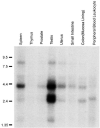A gene highly expressed in tumor cells encodes novel structure proteins
- PMID: 15602574
- PMCID: PMC4518866
- DOI: 10.1038/sj.onc.1207988
A gene highly expressed in tumor cells encodes novel structure proteins
Abstract
We isolated several related but distinct cDNA clones encoding novel structure proteins (NSP) when screening a cDNA library. Analysis revealed that these cDNAs and several similar ESTs in the public databases are derived from a single gene of 17 exons that span a minimum of 227-kb region. This gene is located at chromosome 17p11.2, a region frequently amplified in human gliomas and osteosarcomas, and involved in Birt-Hogg-Dube syndrome, a tumor-prone syndrome. The major coding sequences shared by all isolated transcripts are predicted to encode SMC (structural maintenance of chromosome)/SbcC ATPase motifs and coiled-coil domains commonly seen in motor or structure proteins. Two 5'-end and two 3'-end variants (type 5alpha/beta and 3alpha/beta, respectively) were identified, making a total of four possible transcripts. Both 5alpha and 5beta variants were detected in human testis mRNA, but only type 5alpha was detectable in RNA samples extracted from HeLa cells. The unique carboxyl-terminus of 3beta contains a Ca(2+)-dependent actin-binding domain. Immunohistochemistry studies revealed that NSPs were mostly localized to nuclei. Northern blot analysis demonstrated two major bands and the expression levels are tremendously high in testis while barely detectable in other normal tissues examined. Interestingly, NSP5alpha3alpha is highly expressed in some tumor cell lines. These results suggest that NSPs represent a new family of structure proteins with a possible role in nuclear dynamics during cell division, and that NSP5alpha3alpha may serve as a tumor marker.
Figures







References
Publication types
MeSH terms
Substances
Grants and funding
LinkOut - more resources
Full Text Sources
Molecular Biology Databases
Miscellaneous

